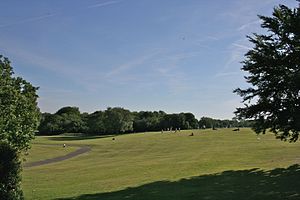Heaton Hall
| Heaton Park | |
|---|---|

Heaton Park, Manchester
|
|
| Type | Municipal park |
| Location | Manchester, England |
| Coordinates | 53°32′05″N 2°15′22″W / 53.5347°N 2.2561°WCoordinates: 53°32′05″N 2°15′22″W / 53.5347°N 2.2561°W |
| Area | 600–650 acres (240–260 ha) |
| Created | 1902 |
| Operated by | Manchester City Council |
| Public transit access | Heaton Park Metrolink station |
| Website | Official website |
Heaton Park is a municipal park in Manchester, England, covering an area of over 600 acres (242.8 ha). The park includes the grounds of a Grade I listed, neoclassical 18th century country house, Heaton Hall. The hall, remodelled by James Wyatt in 1772, is now only open to the public on an occasional basis as a museum and events venue.
Heaton Park was sold to Manchester City Council in 1902 by the Earl of Wilton. It has one of the United Kingdom's few concrete towers, the Heaton Park BT Tower.
The park was renovated as part of a millennium project partnership between the Heritage Lottery Fund and Manchester City Council at a cost of over £10 million. It contains an 18-hole golf course, tennis courts, a boating lake, an animal farm, a pitch and putt course, a golf driving range, woodlands, ornamental gardens, an observatory, an adventure playground, a Papal Monument and a volunteer-run tram system and museum, and is listed Grade II by Historic England. It has the only flat green bowling greens in Manchester, built for the 2002 Commonwealth Games.
Heaton Hall had been owned by the Holland family since the Middle Ages. In 1684, when Sir John Egerton, 3rd Baronet of Wilton, married Elizabeth Holland, the hall came to the Egerton family. In 1772, Sir Thomas Egerton, 7th Baronet (later the 1st Earl of Wilton), commissioned the fashionable architect James Wyatt to design a new home for his young family. Although Wyatt had already established a reputation for himself as an innovative architect, he was only 26 years old and Heaton Hall was his first country house commission. Wyatt's neo-classical masterpiece was built in phases and was mostly completed by 1789.
...
Wikipedia
